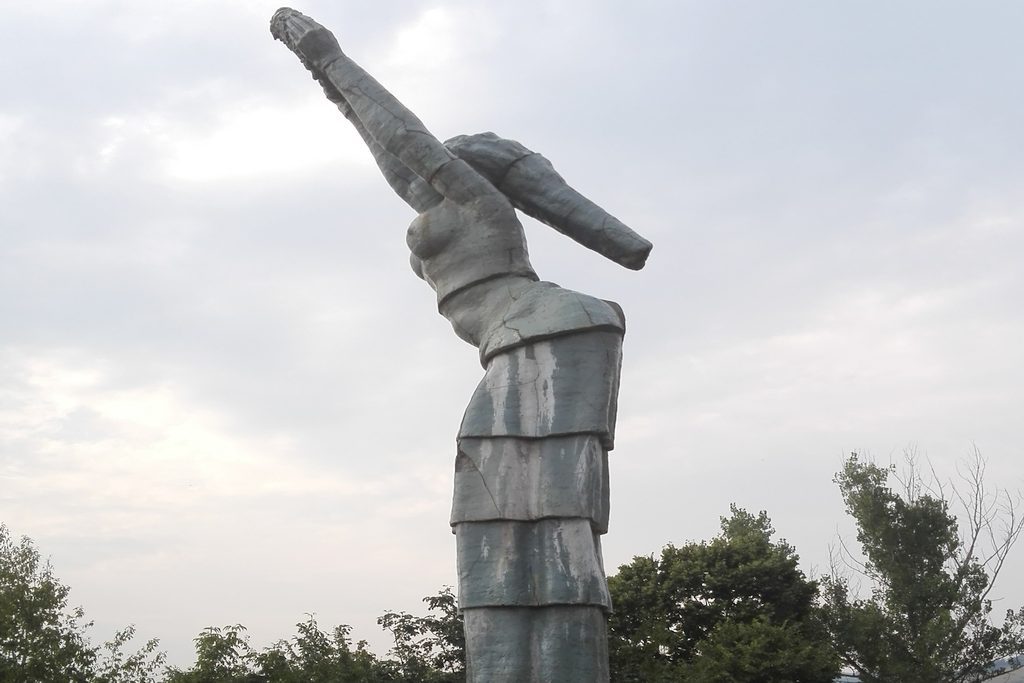

The woman who prepares to throw herself in the waters of the Danube, Danubia, is a symbol, executed at Târnăveni and inaugurated in 1996. The monument, creation of Patriciu (Patrick) Mateescu, Romanian settled in America, honors the memory of the ones who, by the desire of living free, dared to throw themselves in the waters of the Danube, in order to swim towards Yugoslavia, from where there existed the chance of going further, towards the Occident. Some of them didn’t succeed. They died, killed by the rangers or drowned.
Patriciu Mateescu lived in Romania until 1979. He isn’t a “frontierist”, but, as many other Romanians, he found out about the illegal frontier passing from the period of the communists, and before deciding to execute the monument, he heard the fact that in Germany there have been punished the militaries who gave the order of shooting in the Germans who tried to pass the Berlin Wall. He was surprised by the fact that no one from here raised the problem that the number of the victims from the frontiers is much bigger than the number of the victims from the Berlin Wall, which were so promoted. Romania gave to the free world, in the years of the communism, hundred thousands of refugees.
Drobeta – Turnu Severin, frontier city with the former Socialist Federal Republic Yugoslavia, attracted as a magnet throughout the years the Romanians who wanted to escape the poverty from the country. From here, they left towards the states of the world sports people, artists, doctors, engineers, but also simple people, disgusted with the communist regime. Even on the border of the Danube, from the district from Severin Schela Cladovei, you could see the barrier from Porțile de Fier I which was only partially lighted, namely on the Serbian part. On the Romanian border there was obscurity, because of the fact that they wanted to economize the electrical energy.
On the place on which the Danube channel was narrow, around the Cazanele Mari and around the Cazanele Mici, was the best place for leaving the country. In Drobeta – Turnu Severin there was passed the Danube to the Serbians towards the Naval Building Yard or from the area of the Abattoir, in the proximity of the Șimian Island or in front of the outside districts of the sketes – Schela Cladovei and Gura Văii -, in the place where there also were guides. The security men who were infiltrated in the area had among other requests of verifying to the quick each new employee at the few economical unities from here. Only the fishermen were allowed to stay on the border, but only if they had the approval from the rangers. Another “passing” point was also the Balota Hill, situated at a few kilometers from Severin. The fugitives were descending the hill until the Danube in the frontager localities, Hinova and Ostrovul Corbului, where the river was narrower and it could be easily passed, especially during the summer. Another method of arriving at the Serbians, which managed to give a bad time to the authorities from that period, was the one of using the motor-nave which performed regular courses of passengers between Ostrovul Mare and Moldova Veche. When the nave reached the territorial waters of the Serbian state, the fugitives simply jumped in the water and swam until the border.
If they succeeded in passing the Danube, the people with superior education, the well professionally prepared, weren’t returned, but sent in a camp at Padinska Schela, in the proximity of Belgrade. Here there were kept two – three months until they drafted the papers for immigrating in America, Australia, Canada, Germany, France and Austria.
